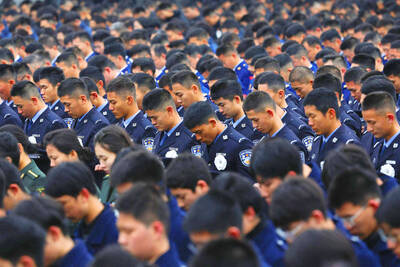Selfies, which have become a global sensation in the past decade or so, have remarkably killed five times more people than sharks.
The death toll has crept up incrementally each year as smartphones become more sophisticated and selfie sticks increase the range at which people can snap themselves, prompting them to take bigger risks for the perfect shot.
Between October 2011 and November 2017, at least 259 people died taking selfies around the globe, according to India’s Journal of Family Medicine and Primary Care, compared with just 50 people killed by sharks in the same period.

Photo: AFP
While women take the most selfies, young men, who are more prone to take risks, make up three-quarters of the selfie deaths — in drownings, crashes, falls or shooting accidents.
India, with a population of more than 1.3 billion and 800 million cellphones, holds the record for the number of people dying in the act of photographing themselves, with 159 recorded so far.
That is more than half of the global total — and a testament of sorts to the nation’s love of group photos and its youthful population.
India has seen selfie-snapping groups of youths die when they were hit by a train or drowning when their boat sank at the moment they were clicking the shutter. The situation has become so dire that India has set up “no selfie” zones — 16 of them in the city of Mumbai alone.
The country came in far ahead of Russia (16 deaths), the US (14) and Pakistan.
In Russia, people have fallen from bridges and high-rise buildings, shot themselves or even died while handling a land mine. Police issued a guide to “selfies without danger” in 2015.
In the US, most of those involved in selfie deaths fatally shot themselves while seeking the perfect pose. A number of people have fallen to their deaths at the Grand Canyon.
Rescue services in Croatia used Twitter to ask tourists to “stop taking stupid and dangerous selfies” after a Canadian miraculously survived a 75m fall in the Plitvice Lakes region.
In January, Taiwanese social media celebrity Gigi Wu (吳季芸) — known as the “bikini hiker” for taking selfies on top of mountain peaks dressed in a bikini — died when she fell into a ravine. She was 36.
Even when they are not fatal, selfies can be extremely macabre. In 2014, a Brazilian woman sparked rage online when she took a smiling selfie in front of the coffin of presidential candidate Eduardo Campos at his funeral.
Social media influencer Sueli Toledo also caused a stir online when she posted a picture on Instagram with the caption: “My look today for the funeral of a super friend.”
Selfies in places deemed sacred or hallowed — especially when they honor the dead — can also raise questions.
At the former Nazi death camp of Auschwitz in Poland, visited by 2.1 million people every year, museum staff do not hesitate to contact people who post selfies deemed to be inappropriate.
From Brazil to Vietnam and Germany, witnesses to traffic accidents have posted selfies at the scene of the crash.
More and more, selfies — even in tourist havens — are becoming a bit of a nuisance for locals.
Residents of the picturesque Rue Cremieux in Paris were so disturbed by the constant stream of selfie-snapping tourists outside their windows that they started their own Instagram account, clubcremieux, where they publish pictures of the most absurd posers outside their doors, skewering them with barbed captions.
The same thing happened in Hong Kong, where residents of the vast multi-colored Quarry Bay apartment complex put up signs banning photos.
Facing the mad frenzy of endless selfies, Vienna has launched a campaign for a digital detox.
The Belvedere Museum has put up a large copy of Gustav Klimt’s classic painting The Kiss near the original and added a giant red hashtag, so that visitors can take their selfie next to the facsimile and actually look at the real work of art.

PARLIAMENT CHAOS: Police forcibly removed Brazilian Deputy Glauber Braga after he called the legislation part of a ‘coup offensive’ and occupied the speaker’s chair Brazil’s lower house of Congress early yesterday approved a bill that could slash former Brazilian president Jair Bolsonaro’s prison sentence for plotting a coup, after efforts by a lawmaker to disrupt the proceedings sparked chaos in parliament. Bolsonaro has been serving a 27-year term since last month after his conviction for a scheme to stop Brazilian President Luiz Inacio Lula da Silva from taking office after the 2022 election. Lawmakers had been discussing a bill that would significantly reduce sentences for several crimes, including attempting a coup d’etat — opening up the prospect that Bolsonaro, 70, could have his sentence cut to

China yesterday held a low-key memorial ceremony for the 1937 Nanjing Massacre, with Chinese President Xi Jinping (習近平) not attending, despite a diplomatic crisis between Beijing and Tokyo over Taiwan. Beijing has raged at Tokyo since Japanese Prime Minister Sanae Takaichi last month said that a hypothetical Chinese attack on Taiwan could trigger a military response from Japan. China and Japan have long sparred over their painful history. China consistently reminds its people of the 1937 Nanjing Massacre, in which it says Japanese troops killed 300,000 people in what was then its capital. A post-World War II Allied tribunal put the death toll

A passerby could hear the cacophony from miles away in the Argentine capital, the unmistakable sound of 2,397 dogs barking — and breaking the unofficial world record for the largest-ever gathering of golden retrievers. Excitement pulsed through Bosques de Palermo, a sprawling park in Buenos Aires, as golden retriever-owners from all over Argentina transformed the park’s grassy expanse into a sea of bright yellow fur. Dog owners of all ages, their clothes covered in dog hair and stained with slobber, plopped down on picnic blankets with their beloved goldens to take in the surreal sight of so many other, exceptionally similar-looking ones.

‘UNWAVERING ALLIANCE’: The US Department of State said that China’s actions during military drills with Russia were not conducive to regional peace and stability The US on Tuesday criticized China over alleged radar deployments against Japanese military aircraft during a training exercise last week, while Tokyo and Seoul yesterday scrambled jets after Chinese and Russian military aircraft conducted joint patrols near the two countries. The incidents came after Japanese Prime Minister Sanae Takaichi triggered a dispute with Beijing last month with her remarks on how Tokyo might react to a hypothetical Chinese attack on Taiwan. “China’s actions are not conducive to regional peace and stability,” a US Department of State spokesperson said late on Tuesday, referring to the radar incident. “The US-Japan alliance is stronger and more